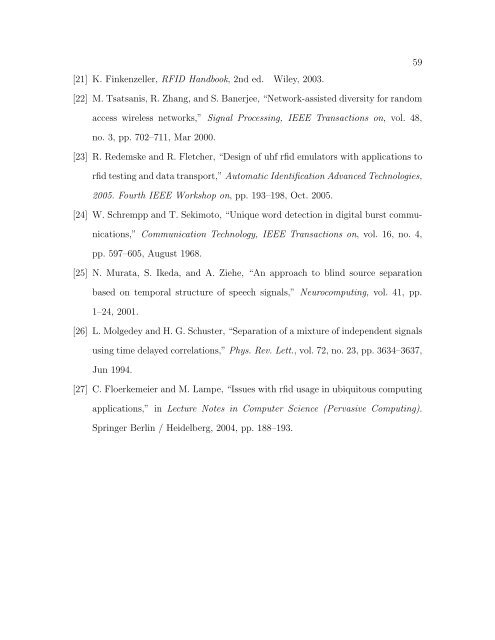utilizing physical layer information to improve rfid tag
utilizing physical layer information to improve rfid tag
utilizing physical layer information to improve rfid tag
You also want an ePaper? Increase the reach of your titles
YUMPU automatically turns print PDFs into web optimized ePapers that Google loves.
[21] K. Finkenzeller, RFID Handbook, 2nd ed. Wiley, 2003.<br />
[22] M. Tsatsanis, R. Zhang, and S. Banerjee, “Network-assisted diversity for random<br />
access wireless networks,” Signal Processing, IEEE Transactions on, vol. 48,<br />
no. 3, pp. 702–711, Mar 2000.<br />
[23] R. Redemske and R. Fletcher, “Design of uhf <strong>rfid</strong> emula<strong>to</strong>rs with applications <strong>to</strong><br />
<strong>rfid</strong> testing and data transport,” Au<strong>to</strong>matic Identification Advanced Technologies,<br />
2005. Fourth IEEE Workshop on, pp. 193–198, Oct. 2005.<br />
[24] W. Schrempp and T. Sekimo<strong>to</strong>, “Unique word detection in digital burst commu-<br />
nications,” Communication Technology, IEEE Transactions on, vol. 16, no. 4,<br />
pp. 597–605, August 1968.<br />
[25] N. Murata, S. Ikeda, and A. Ziehe, “An approach <strong>to</strong> blind source separation<br />
based on temporal structure of speech signals,” Neurocomputing, vol. 41, pp.<br />
1–24, 2001.<br />
[26] L. Molgedey and H. G. Schuster, “Separation of a mixture of independent signals<br />
using time delayed correlations,” Phys. Rev. Lett., vol. 72, no. 23, pp. 3634–3637,<br />
Jun 1994.<br />
[27] C. Floerkemeier and M. Lampe, “Issues with <strong>rfid</strong> usage in ubiqui<strong>to</strong>us computing<br />
applications,” in Lecture Notes in Computer Science (Pervasive Computing).<br />
Springer Berlin / Heidelberg, 2004, pp. 188–193.<br />
59
















